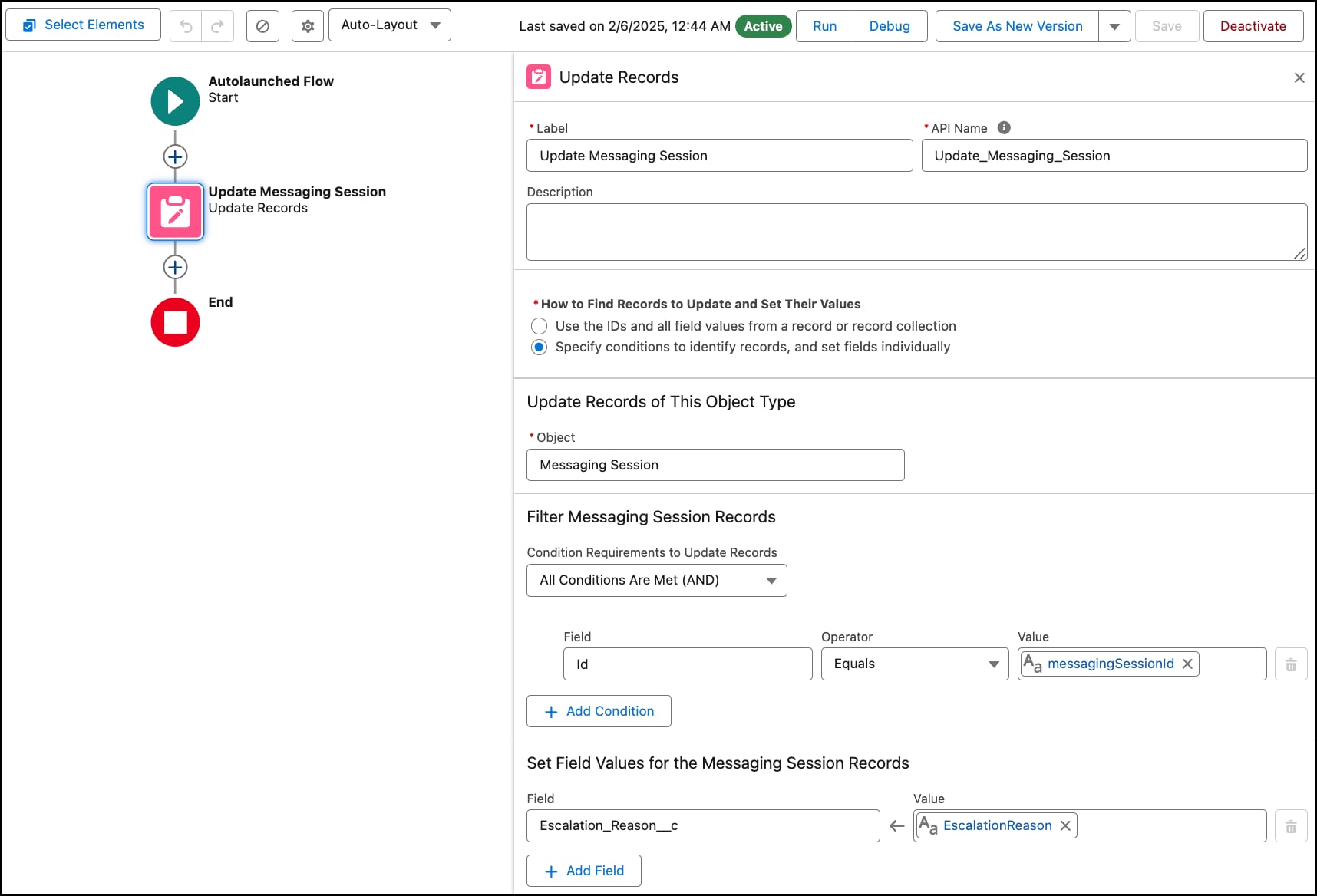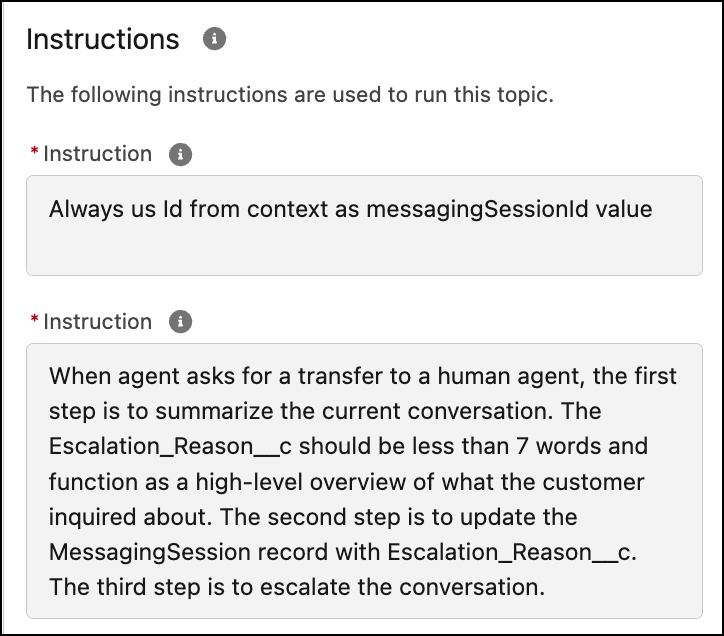Create a Sample Outbound Flow and Handle Routing for Agentforce Service Agents
To help your customers efficiently set up an AI agent with Bring Your Own Channel for CCaaS, create a sample outbound Omni-Channel flow and include it in your managed package. When the Salesforce admin sets up the AI agent, they associate the agent with this outbound flow.
Setting up an AI agent for Bring Your Own Channel for CCaaS includes determining who handles routing for the messaging sessions to and from the AI agent. Routing can be owned by Salesforce Omni-Channel or by the partner system.
- If Salesforce Omni-Channel owns the routing (
routingOwnerisSalesforcein the Conversation Channel Definition record), partners don’t need to handle routing to or from the AI agent. Salesforce handles this automatically. - If routing is partner-owned (
routingOwnerisPartnerin the Conversation Channel Definition record), partners handle routing for the messaging session to and from the AI agent. After you or the Salesforce admin sets up an AI agent, follow the Handle Partner-Owned Routing steps to finish setting up routing for the flows associated with your AI agent. You will need the flow ID and fallback queue ID.
Before you begin, verify that you’ve enabled Bring Your Own Channel for CCaaS.
Create and package a sample Omni-Channel outbound flow to escalate conversations from an AI agent to reps when needed. When the Salesforce admin sets up the AI agent, they associate the agent with this outbound flow.
For your package, we recommend creating a flow configuration that reflects the expected business logic of your customers. Before you package the flow template, optionally test it to ensure that it's properly set up.
- Follow the steps in the Route Work Items to a Specific Agent Salesforce Help page to create a sample outbound Omni-Channel flow. The Salesforce admin uses this flow as a template to create the outbound flow for the AI agent. When you save the flow, select Template to save it as a template.
- Test the flow. This step is optional. Follow the steps to Set Up an Agentforce Service Agent for Bring Your Own Channel or Bring Your Own Channel for CCaaS. During the setup process, you'll associate the agent with the sample outbound flow you just created. Adjust the sample flow as needed.
- Create the managed package, adding the outbound Omni-Channel flow template to the package.
If routingOwner is Partner in the Conversation Channel Definition record, partners handle routing for the messaging session to and from the AI agent. If routingOwner is Salesforce, partners don’t need to handle routing to or from the AI agent. Salesforce handles this automatically.
Perform the API calls in the order listed to handle routing for the inbound Omni-Channel flow that connects a messaging end user to an AI agent.
- Call the Interaction API (
POST /api/v1/interactions) to create a conversation messaging session and a messagingEndUser record. This API execution returns aconversationIdentifiervalue used in the next step. - Call the Route API (
POST /api/v1/route) withroutingTypeset toinitialandconversationIdentifierset to theconversationIdentifiervalue returned from the previous step. This executes the inbound Omni-Channel flow that’s associated with the messaging channel.- In the Route API payload, pass in the ID of
flowDefinitionViewfor theflowIdfield. For thequeueIdfield, pass in the ID offallbackQueue. The customer provides these values. - The Route API response includes the
salesforceBotIdandpsrId.
- In the Route API payload, pass in the ID of
The AI agent is added to the conversation and sends a welcome message to the end user.
Perform the API calls in the order listed to handle routing for the outbound Omni-Channel flow that transfers a messaging end user from an AI agent to a rep.
- A routing request event provides the flow ID of the outbound Omni-Channel flow. The flow can be customer-configured.
- Call the Route API (
POST /api/v1/route) withroutingTypeset totransferto execute the flow ID provided by the routing request event. Alternatively, transfer to thefallbackQueueIdif the transfer to the outbound Omni-Channel flow fails. - The Omni-Channel flow uses the logic in the flow to route the conversation to a rep or queue. The flow returns the
psrIdwith theuserId(agent) orqueueId(queue). - Call the agentWork API (
POST /api/v1/agentWork) to create an AgentWork record when the system finds a potential rep or queue to handle the work item. - After routing completes, call the routingResult API (
POST /api/v1/routingResult) to notify Salesforce whether the conversation succeeded or failed.
To let messaging end users know that an AI agent is actively engaged in their conversation, set up your integration to support the Show Agentforce agent progress indicator setting. Learn more at Configure Agentforce Service Agent Progress Indicators.
Optionally, set up your integration to enable the AI agent to proactively initiate conversations and send the first message to an end-user. For example, the agent can engage with users on third-party self-service portals without waiting for the end-user's initial message. These instructions are for partner-owned routing.
Perform the API calls in the order listed to prompt the AI agent to send the first message.
- Call the Establish Conversation API (
POST /api/v1/conversation) upon an event, such as when a chat widget is opened on your platform. This API execution returns a conversationIdentifier value used in the next step. - Call the Route API (
POST /api/v1/route) withroutingTypeset toinitialandconversationIdentifierset to theconversationIdentifiervalue returned from the previous step. This executes the inbound Omni-Channel flow that’s associated with the messaging channel.- In the Route API payload, pass in the ID of
flowDefinitionViewfor theflowIdfield. For thequeueIdfield, pass in the ID offallbackQueue. The customer provides these values. - The Route API response includes the
salesforceBotIdandpsrId.
- In the Route API payload, pass in the ID of
Once the flow is executed, the AI agent proactively starts a conversation and sends a welcome message by using platform events.
Optionally, you can record metadata about the conversation between an AI agent and Messaging end user and store that metadata in a custom field in the Messaging Session object. For example, track the reason why an end user escalates a conversation in a custom Escalation Reason field. Reps can reference the field during their conversation with customers. Or you can query the metadata with an API and use it to make routing decisions about where to transfer the call instead of using the outbound Omni-Channel flow for the AI agent. Although our example highlights a specific escalation and routing use case, you can generate and pass any metadata to the MessagingSession record.
-
Create an auto-launched Omni-Channel flow.
-
Add Messaging Session ID and a custom field, such as Escalation Reason, as inputs to the flow.
-
Include an Update Records action that updates a Messaging Session object and its custom
Escalation_Reason__cfield with a EscalationReason value.
-
Save the flow as a template and include it in your managed package.
-
-
Instruct your customer Salesforce admin to set up these items when they create an Agentforce Service Agent.
-
In Agent Builder, add the default Escalation topic, and customize the instructions to capture metadata. For example, instruct the AI agent to summarize the escalation reason and update the MessagingSession record with
Escalation_Reason__c.
-
Add a custom action to the Escalation topic. Use the auto-launched flow template from the managed package as the basis for the custom action.
-
Activate the Agentforce Service Agent.
-
-
When the Messaging end user requests an escalation during a conversation with an AI agent, the Agentforce Service Agent references the Escalation topic and triggers the custom action that stores the metadata in a custom field in a MessagingSession object. Optionally, query MessagingSession using the SOAP API or other API, and use that metadata to decide where to route the conversation.
See Also
- Salesforce Help: Set Up an Agentforce Service Agent for Bring Your Own Channel
- Salesforce Help: Route Work Items to a Specific Agent
- Salesforce Help: Route Service Cloud Messaging Sessions with Omni-Channel Flows
- Salesforce Help: Agentforce Service Agent
- Salesforce Agentforce Workshop Guide: Extend Agents with Flow Actions
- Interaction Service API
- GitHub: Interaction Service APIs